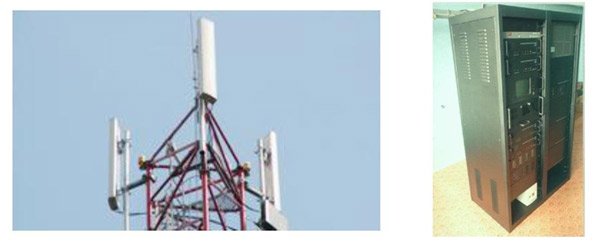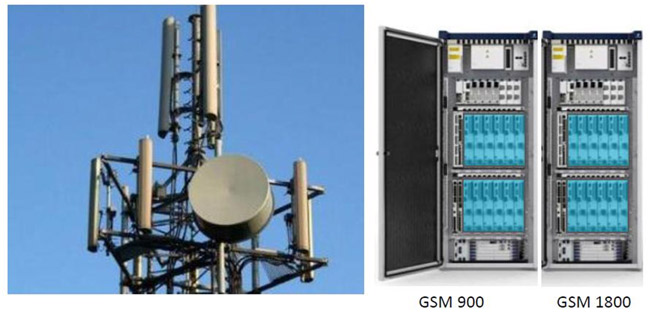Single RAN: “shrink” BS without sacrificing performance

The base station after launch would look something like this if it were not for Single RAN
Literally, Single RAN stands for “Single Radio Access Network” - a single radio access network. To understand what it is, we will have to go back decades, in the era of the first mobile networks. For example - D-AMPS, with which he began in the 90s, in particular, Beeline.
Then everything was very simple. One D-AMPS communication standard, one frequency band - 800MHz, one base station that creates coverage. It would seem that everything is great! However, the capacity of the D-AMPS standard is small, there is practically no additional functionality other than voice, and very soon the operators are switching to the GSM standard, which was immediately available already in 2 frequency bands: 900MHz for maximum coverage, and 1800MHz for maximum network capacity.
')

D-AMPS standard base station and antenna system for it.
Technical Evolution: More Standards
Each band, even within one standard, requires its own base station, with its own control units, transmitters and antennas. If we want to keep the D-AMPS network that previously worked, then the number of base stations at each site reaches 3 pieces, and the antennas on the mast - 6-9 pieces.
Fortunately, the time for complete disconnection and dismantling of equipment for D-AMPS networks is well in place, which will allow to slightly reduce the number of racks and antennas.

GSM dual band (900 / 1800MHz) site with antenna system.
After a short time, the growing need for data transfer and obtaining a license for 3G networks oblige the operator to begin deploying a UMTS network in the 2100 MHz band, and in some cases even 900 MHz. Later, the active development of the LTE standard can not leave aside any operator who wants to remain among the market leaders. For Russia, it was decided to deploy LTE networks in the 800MHz and 2600MHz bands.
Now, if we evolve along the standard network construction path, we must add more equipment to support all standards (GSM / UMTS / LTE) and all bands (800/900/1800/2100 / 2600MHz), including racks of base stations with transmitters, control units , transport units and antennas.
It is easy to calculate that in one room we have to mount 2 racks of GSM-base stations (900MHz + 1800MHz), up to two UMTS (2100MHz + 900MHz) and 2 base stations LTE (800MHz + 2600MHz).
The number of racks increased to 6, the number of antennas on the mast - at least up to 12 pieces! At the same time, a separate transport may be required for each standard to transfer traffic to the operator, and the technology for this transport can also be used for each mobile communication standard - its own. For example, GSM base stations will transmit data over E1 channels, UMTS base stations over ATM, and LTE bases over IP / Ethernet.
It is difficult to find a living example of such a bulky configuration of the site of the base station, but it should be something similar to the photo before kata. Such five-band sites (800/900/1800/2100 / 2600MHz) of GSM / UMTS / LTE standards, with an antenna system, is a highly inefficient solution that needs to be optimized in all possible parameters: number of racks, dimensions, number of antennas, transmitters, control units, used transport channels.
This is where the Single RAN concept appears: ensuring the operation of all mobile network standards (GSM / UMTS / LTE) using the minimum amount of equipment at the base station site. Ideally, a base station conforming to a Single RAN standard should look to an outside observer as 1 base station rack with a set of universal transmitters and control units with a common IP / Ethernet transport channel for all mobile communication standards. Antennas in this case it is necessary to use broadband, cross-polarized, arranged on 2-3 pieces in one case.

Five-band Single RAN site (800/900/1800/2100 / 2600MHz) of GSM / UMTS / LTE standards with antenna system.
From the outside, this again looks like the first D-AMPS base station, which worked in just one standard. But now it’s a completely disparate level of services provided, several radio access technologies and huge capacities for subscribers.
Such minimization and unification became possible due to the long work carried out by manufacturers of equipment for mobile networks, the standardization process that is constantly carried out in special organizations and achievements in the field of modern microelectronics. Now one transmitter in any range can simultaneously operate in several standards at a given frequency, and one control unit, after adding a small board, is able to process traffic from these multistandard transmitters and send it via a common transport channel to the operator’s site.
Of course, the Single RAN concept also includes requirements for equipment in the operator’s network, such as BSC / RNC / MSC / SGSN, control systems and transport networks, all of which allow minimizing the amount of equipment and using it with maximum efficiency for the development of a mobile network.
How it looks in practice
The installation of the Single RAN solution is possible only if a number of conditions are met that are very difficult to sustain in the network of an operator operating in the market for several years. The main condition for the implementation of Single RAN - equipment of all standards (GSM / UMTS / LTE) must be from one manufacturer. If the operator has been working in the market for a long time, the situation is usual when one supplier acted as the GSM equipment supplier, the second one served UMTS equipment, and the third LTE. For such a development scenario, the transition to Single RAN is possible only with the involvement of large-scale investments, and the transition to the equipment of one manufacturer.
When the first condition is fulfilled, the second condition arises: it is necessary to use modern equipment that supports SDR technology (Software-Defined Radio) and is based on production technology that ensures sufficient performance and minimizes the size of components used in base stations.
Solutions based on these approaches have been offered on the market for only a few years, so in fact this also means replacing the equipment of the existing GSM / UMTS standards when deploying a Single GSM / UMTS / LTE RAN solution.
All new networks that are planned and built at present are based on the principle of Single RAN , and existing networks are undergoing planned modernization, which will be completed within a few years.
Source: https://habr.com/ru/post/186040/
All Articles